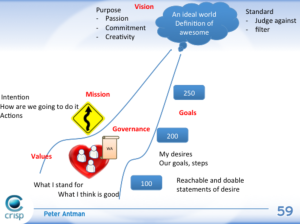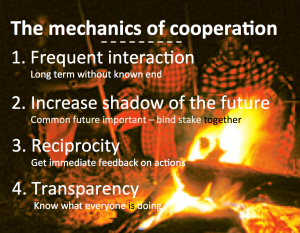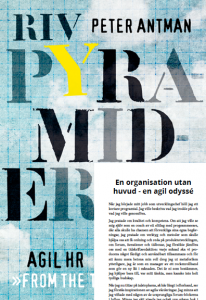The Spotify ‘model’ was presented in 2012 and has stired a lot of interest in the agile community and the software industry in general. In May I was asked to talk about this a the Bay Area Agile Leadership Network meetup in San Francisco (where I at that time was working as an agile coach
Continue readingPeter Antman
Better meetings with the Core Protocols

Good meetings is very much about achieving deep collaboration. But collaboration is often hard. We go into meetings with different modes, intentions, and expectations. How can we make meetings both more fun and energetic? Surprisingly enough: maybe by being more formalized.
Continue reading
Fluent@agile – visualizing your way of working
Help your team improve by visualizing their way working with the fluent@agile game. With the game you can help a team find out where it is on its agile journey and help it find new ways of both fine tuning and make leaps in their daily agile practices.

Me and Christian Vikström made the game together at Spotify during the spring 2014 when we were coaching and helping team to improve their agile skill sets and processes.
At Spotify the teams owns their own way of working. A team is basically only accountable to itself. We therefore needed an coaching tool that could help team take ownership of their self image and improvement strategy.
We also wanted the tool to be opinionated. It should be normative, tell what’s good and not, what kind of practices and behaviour that’s expected and not. But at the same time it should be open to new ideas, new practices and the teams local conditions.
Continue reading
The Pirate Ship – Growing a great crew: a workshop facilitation guide
The Pirate Ship is a workshop format that will help you grow amazing teams. It is “speed boat” on steroids. I have now been using it for a couple of years, and the time have come to share this useful and productive format.
I do a lot of workshops with teams. Very often the workshops are about the teams themselves. It can be anything from getting a newly started team up and running to helping a mature and stable team find new inspiration and challenges.
Samarbetets myserier på Agila Sverige 2015
Samarbete är en svår konst. De flesta organisationer har grava underskott på samarbete. Ännu saknas på många sätt förståelse för vilka mekanismer som driver och uppmuntrar samarbete. På Agila Sverige 2015 pratade jag om samarbetets mystik och gjorde några nedslag i en längre workshop om detta. Bland annat visar jag hur man kan spela ultimatumspelet i storpublik, hur apor reagerar på orättvisor och de fyra pelarna i samarbetets mekanik.
Tillsammans – så river programmerarna företagspyramiderna
I år hade jag äran att i anslutning till Agila Sverige (2015) släppa Riv pyramiderna igen som riktig bok med den mycket bättre titeln Tillsammans – så skapar du flyt och egenmakt med agile och lean (tack till Joakim Holm för att du övertalade mig att negativa titlar är dåliga). Den hemliga undertiteln tycker jag
Continue readingA Decade of Agile, A – F
A decade of agile boils down to theses simple fundamentals and steps for me. A. Ask: do you need to improve as an organization? Only go forward if your sincere answer is yes. Ask everyone: Do you want to improve? Same procedure. Make sure you will fail (and win) regularly by commitment (plan/hypotheses) and checkpoints.
Continue readingAgil HR på IDG
10 oktober anordnade IDG Rekrytering & Ledarskap ett frukostseminarie om Agil HR för dryga 100 HR- och IT-chefer. Jag var inbjuden för att prata om ämnet och min nya bok Riv pyramiderna igen. Vi hade också en kortare paneldebatt om ämnet med bland andra Matti Klasson från King och Gabriella Ekström på SVT (som bloggat
Continue readingThe Agile Meetings Cube
Agile facilitators, be aware, now you are about to be replaced – by a cube. Just kidding. But have you ever felt that your meetings are not on track? Or that you have a hard time doing the elevator pitch for that backlog grooming meeting you would like your team to have? Or do you meeting often ends in thin air? Comes your rescue: The Agile Meeting Cube.

The Agile Meeting Cubes gives you purpose, expected outcome and a suggested checklist and possible tools to use for six classical Agile or Scrum Meetings:
- Release Planning
- Backlog grooming
- Sprint Planning
- Daily Standup
- Sprint Review
- Sprint Retrospective
Download it from conceptcubes.com and do the following:
Continue reading
Facilitating the Elephant Carpaccio Exercise
One of the best exercises I know of on how to learn and practice User Story slicing techniques is the so called Elephant Carpaccio exercise. At Spotify it is something of a staple as it it is (often) used when introducing new employees (now a days). Facilitating the Elephant carpaccio exercise from Peter Antman The
Continue readingLet the User Story Flow
One of my biggest surprises when I first met the squads I where going to work with at Spotify was that none of them were using User Stories. At first I observed to see their alternative. Unfortunately there was none. Instead most of the work got done as big chunks of work (what I would tend to call Epics) that was sliced into a todo-list of tasks (named that way by the developers) and also divided according different platforms.
Squad focus on technical tasks
A typical board contained one or more business cases and lanes for each developer/platform with tasks that were executed upon. These big “busses” where on the board blocking other works for weeks, which of course meant there needed to exist one or more emergency lanes for all expedite work (in the long run, most work).
This is a setup that does not foster collaboration, focus on value and art-of-the-possible. From an agile fluence point of view I would say it is a way of working that does not even reach fluence level 1 (Christian and I will describe agile fluence in more depth in a follow up blog post). From my experience focusing on User Stories is a great way of fostering the above values, and reach fluence level 1.
Lean Canvas – an hypotheses board
As so many others I’m inspired by the book Lean Startup. The idea of experimenting with your business model and deliver just the bare stuff needed to validate (or actually try to refute) your business hypothesis is so enticing. But how do you do that when you are one of 50 or 100 teams? How do you do that when the teams are not even using User Stories? How do you do that when daily work is done on a Kanban board only showing tasks?
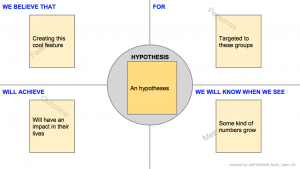
One part of a possible solution is to find a way of visualizing the business case. A popular approach has become setting up a business board, often called a Lean Canvas. I wanted to try something like that. But going trough all the different variants I could find, no one was good enough in itself. I wanted to get the same feeling as with User Stories: a simple formula that everyone can understand and use as soon as the formula is presented.
My Spotify tools
Last week i quit my assignment at Spotify. I was there to help and act as a stand-in for Joakim Sundén while he was on paternity leave. He’s now back in the saddle as Agile Coach in the More Than Music Tribe. I had the pleasure to work closely with the Agile Coach Christian Vikström on Spotify and together we have been coaching the Browse, Growth and Customer Support squads. A was also a member of the tribe management team, and together we did some new interesting stuff.
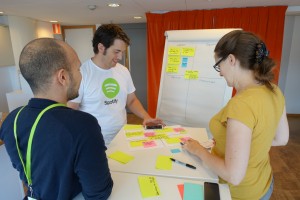
It’s has been fascinating and fantastic to work with such dedicated people and a product that has such a traction. Spotify is also really trying to build an awesome and agile organization and culture that can win and sustain in the long run. What is there to do at such a fantastic company? That’s a reasonable question. A lot I discovered. Spotify is shock full of super smart people, but many of them has not worked there for long, many of them has not worked long at all, teams have been newly formed and are under constant change. Simply put: even Spotify needs a lot of basic agile coaching.
When I now look back at what we did during these last 8 month I see a lot of tools and experiences that I think others also can find useful. During the next couple of month I will share them through this blog. Hope you will find them useful. Here’s the planned list:
Facilitating from the Back of the Room at Spotify
Last week Jimmy Janlén and I held a shortened version of our course Training from the Back of the Room for our former colleagues at Spotify. Actually it is not “our” course, but Sharon Bowmans. It’s based on her books about how create a more engaging learning experience in the class room, especially when training adults.
“I really liked the whole setup of this course – a really well organised and inspiring day. Wow :-)”
Jimmy and I are certified trainers of this course. We use the techniques when we do training. But we have also experienced how useful they are in other coaching and facilitation situations, such as workshops and retrospectives. Almost any meeting can be made more engaging and with longer lasting result with the set of tools TBR provides.
We have chosen to call the shortened training Facilitating from the Back of the Room, since that is what we agile coaches do most. 16 persons from the Spotify Agile Guild showed up this beautiful day in a corner room on the 17:th floor in High Tech building with amazing views over Stockholm city. We have to admit we were a little nervous at first. Would this actually make sense to coaches? It did.
Consensus slides and speech from Agila Sverige 2014
At Agila Sverige 2014 I talked about consensus, what it is, why it is the basis for creating good and strong decisions that is often already implemented when the decision is finally made. I also talked about the hand signals we use at Crisp to manage our consensus decision process (read more about it here).
Here’s my slides, that contains more on howto facilitate consensus decision making:
Continue reading
Stop-the-line spoken word performance
På Agila Sverige 2012 höll jag min första ignite i form av en Majakovski- och Bob Dylan-inspirerad Spoken World performance om hur vi på Polopoly skapade kvalitet genom extremt fokus på automatiserade tester och en stoppa-bandet-kultur. Förra veckan fyllde konsultbolaget Adaptiv 5 år och firade genom att låte en utvald skara Agila Sverige-talare reprisera sina
Continue readingLearning flow with the Lean Dot Game
Yesterday we had one of our regularly occurring so called Agile Lunch & Learn in the tribe at Spotify I currently work. We wanted to make the lunch about why it is often better not to work and focus on flow than to maximize your work and focus on resource efficiency. I searched for something in the Crisp bag of games. Pass the pennies – more about big batches. Kanban tothpicks – to many rounds and variables. Folding envelopes – again more batches. Eventually I found the Lean Dot game.

What a find! This game will be with me for a long time. The best flow game there is, with extremply simple props: post-it notes and colored dots. You can run it in an hour and get tons of experiences and stuff to discuss, such as:
- Why it’s better to slow down
- Adapt to bottlenecks
- Batch sizes
- Little’s law illustrated
- Waste and inventory
- Customer collaboration
- In process testing
- And more, and more, and more…
Crisp consensus model 2.1
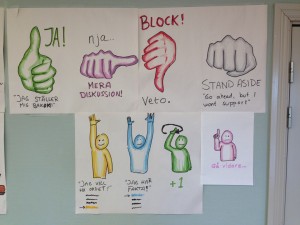
At Crisp we try to use consensus when making important decisions. Why do we do that?
Crisp is a very flat company. Most of us have no boss and report to no one. Basically you can be part of Crisp in two ways: either you have your own firm and have a partner contract with Crisp (all consultants have this) or you are employed by Crisp (administrative personnel). Crisp is owned by most (but not all) of the members/partners. The owners have, however, renounced their right to run the company (from all but legal necessities). This means that the company is run by all partners and employees with an equal vote each. We no longer have a CEO and we elect our board. This means we have to have good ways of making decisions together. And consensus is a very good way of making decision in a flat group like ours.
A bug is just an unwritten test that failed
In the first week of March I attended two Spotify unconferences about Continuous Deliver and Quality (which I also had the pleasure to facilitate). I am amazed on how many we were (people had flown in from a lot of other places), the energy in the room, the quality of the discussions, and the massive
Continue readingDelagardrivet och upplevelsebaserat lärande
I juni kommer min kollega Jimmy Janlén och jag hålla kurs i deltagardrivet och upplevelsebaserat lärande. Vill vi hjälpa andra att upptäcka och praktisera sätt att skapa sant engagerande och lärande undervisning, presentationer och workshops. Kanske slipper ni då mina egen långa resa bort från katedern.

Så vitt jag minns det var jag 24, kanske 25 år. Jag och min vän Göran hade blivit inbjudna att hålla föredrag inför en större samling människor. Det hade jag aldrig gjort förut. Visst var jag van att prata inför andra människor, från seminarierna på universitetet till redaktionsmötena på vår lilla tidsskrift, men inte att hålla tal. Jag gjorde det som kändes säkrast. Jag skrev ett tal och läste sedan upp det.
Förutom att det tog jättelång tid att skriva talet, så kändes det inte bra att stå där och läsa rakt upp och ner. Visst försökte jag läsa med inlevelse och dramatik, ungefär som när man läser högt för barnen, men det kändes ändå inte bra. Höll inte åhörarna på att somna? Lärde de sig alls något? Det går att trollbinda en publik med högläsning, om man berättar en riktigt bra historia. Göran var bra på det, men inte jag. Något behövde jag göra annorlunda.
Agile People i Göteborg
Den 3:e december var jag inbjuden till nätverket Agile People i Göteborg för att tala om min bok Riv pyramiderna igen. Det var god uppsluting av människor som ville prata om hur HR påverkas av när en organisation börjar använda agila värden och principer från lean; och hur HR själv kan inspireras av ett iterativt
Continue readingVisa att du verkligen kan programmera
I det nya kapitlet “Hitta rätt folk – konsten att rekrytera” i boken Riv pyramiderna igen – agil HR from the ‘trenches'” skildrar jag hur vi skapade en för oss passande strategi och metod för att kunna rekrytera rätt folk till våra team. Här kan du läsa ett utdrag:
“Så vitt jag minns det kom förslaget till nästa initiativ från en diskussion om rekrytering med teamen. Minns jag rätt tyckte man att min utfrågning inte gav tillräcklig bra underlag för att verkligen förstå om kandidaterna var bra programmerare. Vi brukade förvisso be om arbetsprov, men många hade inga sådana av med tillräcklig verkshöjd och det var också svårt att utveckla någon form av rimliga kriterier som kunde användas att bedöma kodexempel av väldigt olika sort.
Continue reading
Nytt matigt kapitel till Riv pyramiderna igen
På ett bräde blev boken Riv pyramiderna igen dubbelt så tjock (222 sidor) med det nya kapitlet “En organisation utan huvud – en agil odyssé“. I den gör vi en historisk, praktiskt och teoretisk resa från apache-indianerna, över Ford, Toyota, Lean, Scrum, Agile, flödeseffektivitet, Hegel, Kant, hur det påverkade oss och mycket mer. Slutstation:en massiv
Continue readingBokomslag till Riv pyramiderna igen
I dagarna fick jag bokomslaget till boken Riv pyramiderna igen – Agil HR ‘from the trenches’ jag håller på att skriva på Leanpub. Jag är otroligt nöjd med det. Omslaget är gjort av Lisa Zachrisson. Så här skriver hon om tankarna bakom formgivningen: Jag tyckte att titeln skulle vara stor då det fungerar bra när
Continue readingInterview with Peter Antman on software development
In May this year I was interviewed at the SmartBear MeetUI user conference in Stockholm about my background as a journalist, Linux and open source, software development in general and testing more specifically. Here’s a post containing the video and interviews with the other speakers at the conference. Interview with Peter Antman
Continue readingNy bok: Riv pyramiderna igen – Agil HR ‘from the trenches’
Idag publicerade jag den första versionen av min nya bok Riv pyramiderna igen – Agil HR ‘from the trenches’. Boken tar sin utgångspunkt in min blogserie om Agil HR, som härmed fortsätter i bokform på Leanpub. Jag räknar med att den är cirka 50 – 70 procent klar och kommer färdigställas under hösten. Köp nu,
Continue readingKompetens i det dagliga arbetet
Finns nu i bokform på Leanpub
Kompetens i det dagliga arbetet
Detta är avsnitt två i delen om Ny kunskap - ett gemensamt ansvar i serien Agil HR from the trenches
Kompetensspridning via team
Låt oss börja med att ställa några ledande frågor:
- Arbetar ni i team som innehåller alla kompetenser som krävs för att leverera slutprodukten?
- Är det tillåtet (och helst uppmuntrat) att jobba tillsammans med en uppgift (till exempel parprogrammera)?
- Får team arbeta med saker då och då som de inte kan innan (ny domän, ny teknologi)?
- Kan man (kanske inom rimliga gränser) själv välja vilket team (och därmed område) man vill arbeta i?
Om du svarar ja på alla dess frågor kan du antagligen gå vidare till nästa avsnitt direkt. Om du svarar nej på samtliga, då skulle jag gissa att du både har stora utmaningar att alls leverera saker och att få till utveckling av yrkeskunskap på jobbet. Det kommer också vara ytterst svårt, eller omöjligt, att kompensera den sorts evigt pågående kompetensutveckling som uppstår ur att organisera arbetet på ovanstående sätt med andra former av åtgärder.
Continue reading
Ny kunskap – ett gemensamt ansvar, avsnitt 1
Finns nu i bokform på Leanpub
Detta är den femte posten i en serie om agil HR “from the trenches”.
Del 1: Continuous investment
Del 2: Lägg ner utvecklingssamtalen
Del 3: Lön är rättvis ersättning – inte belöning
Del 4: Släng titlarna
Del 5: Ny kunskap – ett gemensamt ansvar, avsnitt 1
Del 5: Kompetens i det dagliga arbetet, avsnitt 2
Del 6: Hitta rätt folk – släpp dem lös
Ny kunskap – ett gemensamt ansvar, avsnitt 1
Att vandra runt i gamla industriområden ger en märklig känsla av hur tillfälligt mycket är. I ena ögonblicket en plats full av meningsskapande aktivitet, i nästa, rostande maskiner i regnet.
I den yrkesvärld där jag varit verksam sedan slutet av 90-talet, nämligen mjukvarubranchen, är det en känsla som är lätt att känna igen när man arbetar med äldre kod. Ofta räcker det att gå tillbaka till något man själv skrivit för ett par år sedan för att få den där upplevelsen av något otidsenligt och främmande, som egentligen sedan länge borde vara övergivet. Den som inte kontinuerligt utvecklar sitt yrkeskunnande i denna bransch riskerar snabbt att bli likt en rostande maskin.
Continue reading
Stop the line presentation at SmartBear MeetUI
Sisyphus, artistry, cult of quality, weaving, broken windows and all the other stuff you have to care about if you want to build high quality software. Here’s my speech on how we did it at Atex Polopoly, held at the SmartBear MeetUI user conference May 23 2013. And here’s the slides: Build Quality In: Stop
Continue readingStop the line song
I ended my talk on the SoapUI user gathering MeetUI singing the stop the line song. Now it has ended up on youtube. Here’s the text: I keep a close watch on these tests of mine I keep my Jenkins open all the time I see a defect coming down the line Becuse you’re mine,
Continue reading
